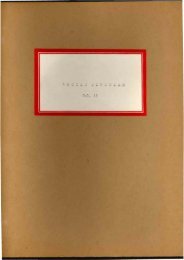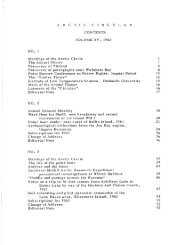Volume 4, 1951 - The Arctic Circle - Home
Volume 4, 1951 - The Arctic Circle - Home
Volume 4, 1951 - The Arctic Circle - Home
Create successful ePaper yourself
Turn your PDF publications into a flip-book with our unique Google optimized e-Paper software.
R.C.M.P. detachment at Old Crow. This house was, for<br />
several years, reported to be the finest house north of<br />
the Ar-ctic <strong>Circle</strong> in North America. <strong>The</strong> supply boat from<br />
Dawson did not arrive until July land throughout June the<br />
men ate "mousey" rice, found in the house, wild garlic,<br />
Allium sp., and fish.<br />
<strong>The</strong> party at Bathurst Inlet captured many species of<br />
insects indigenous to the Boreal forest. This suggests that,<br />
during a good part of the summer of <strong>1951</strong>, the prevailing<br />
meteorological conditions were such that these insects were<br />
carried a few hundred miles north of their normal habitat.<br />
Johnny Bourassa, the well-known bush pilot, flew the party<br />
in and it was on his return flight from Bathurst Inlet that<br />
he was forced down and lost.<br />
<strong>The</strong> Spence Bay investigations supp1emented the insect<br />
collections made by Commander J.O. Ross during the Ross<br />
expedition of 1829-33 in the Boothia Peninsu1a region.<br />
Similarly, the party at Alert, in northern Ellesmere Island,<br />
supplemented the insects collected during the Nares expedition<br />
of 1875-6.<br />
<strong>The</strong> entomological work at Hay River and Ste Anthony<br />
provided information that will be of value in our studies of<br />
the distribution of biting flies and other insects of northern<br />
North America.<br />
<strong>The</strong> descriptions of insects collected by the early<br />
exp10rers are often inadequate for specifie recognitioni<br />
moreover, in many instances the specimens are lost, are<br />
badly damaged, or are in museums not easily available for<br />
study. It is therefore necessary to revisit those areas to<br />
obtain and recognize the specijs that were described. This<br />
avoids confusion in the application of names to those species.<br />
Our investigations have shown that many arctic insects require<br />
several years to complete their development from the agg to<br />
the adult stage. Sorne species do not appear in the adult<br />
stage every season, and to obtain a representative collection<br />
of every species from one arctic locality, it is often necessary<br />
to continue the investigations for two or three successive<br />
years.<br />
A total of 38 arctic and subarctic localities have now<br />
been investigated in the course of the Northern Insect Survey.












